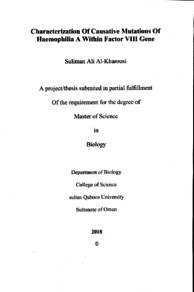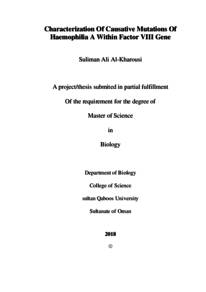Document
Characterization of causative mutation of haemophilia a within factor viii gene.
Publisher
Sultan Qaboos University
Gregorian
2018
Language
English
English abstract
Hemophilia A (HA) is one of the most prevalent X-linked recessive inherited coagulation disorder of variable severity .It occurs in approximately one in every 5,000 male births worldwide ,and encompassing almost 80–85% of hemophilic patients. The disease is caused by deleterious mutations in the factor VIII gene (FVIII) resulting in a dysfunction of coagulation factor VIII an essential cofactor of
the intrinsic pathway of the clotting mechanism. Haemophilia A is considered as a
health problem in Oman. 156 patients have been diagnosed with severe haemophilia
A. There have been no genetic studies done previously to determine the molecular
Vere defects causing this disease. The current study aims to identify FVIII gene mutations in HA patients in Oman. Twelve HA were included in this study. Genomic DNA was isolated from blood by DNA Midi Kit QIAGEN. To screen the genomic DNA for molecular defects, the following was done. First, Screening for inv-1 and inv-22 were done by IS-PCR method. Second, DNA sequencing was performed by Sanger method for all 26 exons of factor VIII gene. PCR products were sequenced using ABI 3130 Genetic analyzer. The sequence results were analyzed using SeqScape v2.6 and Bioedit programs. In order to predict the possible impact of a variation on the function of factor VIII gene, the online tools Polyphen 2, and Swiss-pdb Viewer were used. Out of 12 patients tested, 1 patient was positive for inv-1 and 8 patients were positive for inv-22 (68%). 2 novel missense mutations were found, c.1594T>C, p. (W532R) in exon 11 in one of the patient which was associated with severe hemophilia A phenotype and c.446C>G, p. (P149A) in exon 4 in another patient which was associated with mild hemophilia A phenotype. We conclude that inv-22 is responsible for about two third of disease causing mutations in sever haemophilia A patients in our samples. The data presented in this study can be used for genetic counselling. It also can be used as the basis of future genetic analysis of the disease
Member of
Resource URL
Arabic abstract
يعتبر مرض الهيموفيليا A مرض وراثي متنحي يعرف بمرض الناعور، وهو من اكثر الأمراض المرتبطة بالكروموسوم X انتشارا، ويحدث تقريبا في واحد من اصل 5000 ذكر على مستوى العالم، ويشكل ما يقارب 80 الى 85% من مجموع مرضى الهيموفيليا. يحدث هذا المرض بسبب طفرات وراثية تحدث في جين العامل 8 الذي ينتج بروتين يعد من أحد البروتينات الأساسية لتجلط الدم. يشكل مرض الهيموفيليا A مشكلة صحية في عمان ، حيث يبلغ عدد الأشخاص الذين تم تشخيصهم حوالي 156 مريضا يعانون من هذا المرض. ولم يتم إلى الآن عمل أي دراسة لمعرفة الطفرة الوراثية المسببة للمرض .تهدف الدراسة الحالية إلى التعرف على الطفرات الوراثية في جين العامل 8 في مرض هيموفيليا A في سلطنة عمان. وتشمل هذه الدراسة 12 مريضأ من مرضى الهيموفيليا A. تمت في هذه الدراسة استخلاص الحمض النووي DNA بواسطة عدة استخلاص الحمض النووي DNA من شركة Qiagen ، وتم فحص الانقلاب-1 و الانقلاب-22 بواسطة طريقة IS - PCR ، أما تتابع الحمض الأميني DNA فتم تنفيذه بواسطه طريقة سانجر لعدد 26 إكسون من اكسونات العامل 8. بعدها تم تحليل تتابع الحمض النووي DNA بواسطة برنامج Seq - scape و Bioedit .في حين تم استخدام برنامج Polyphen2 و Swiss - pdb Viewer للتنبؤ بمدى تأثير الطفرة على البروتين. وكانت نتائج هذه الدراسة على النحو التالي: 1 من اصل 12 مريض لديهم انقلاب-1 و 8 مرضى من اصل 12 لديهم انقلاب-22 (68%). كما تم تحديد طفرتين جديديدتين من نوع missense وهما . c . 1594T > C , p (W532R) في إكسون 11 في أحد المرضى وهذه الطفرة مرتبطة بالنوع الحاد للطراز المظهري وأيضا الطفرة ( c . 446C > G , p . ( P149A في إكسون 4 في مريض آخر. وهذه الطفرة مرتبطة بالنوع البسيط للطراز المظهري. نستنتج أن الإنقلاب 22-inv مسؤول عن حوالي ثلثي الأمراض المسببة للطفرات في مرضی الهيموفيليا A الحاد في عمان. وسوف تلعب البيانات المقدمة في هذه الدراسة دورا مهما في تقديم الاستشارات الوراثية والرعاية الصحية للعائلات التي لديها مرض الهيموفيليا A في عمان. كما أنها قد تشكل الحجر الأساس للدراسات المستقبلية في هذا المجال.
Category
Theses and Dissertations


